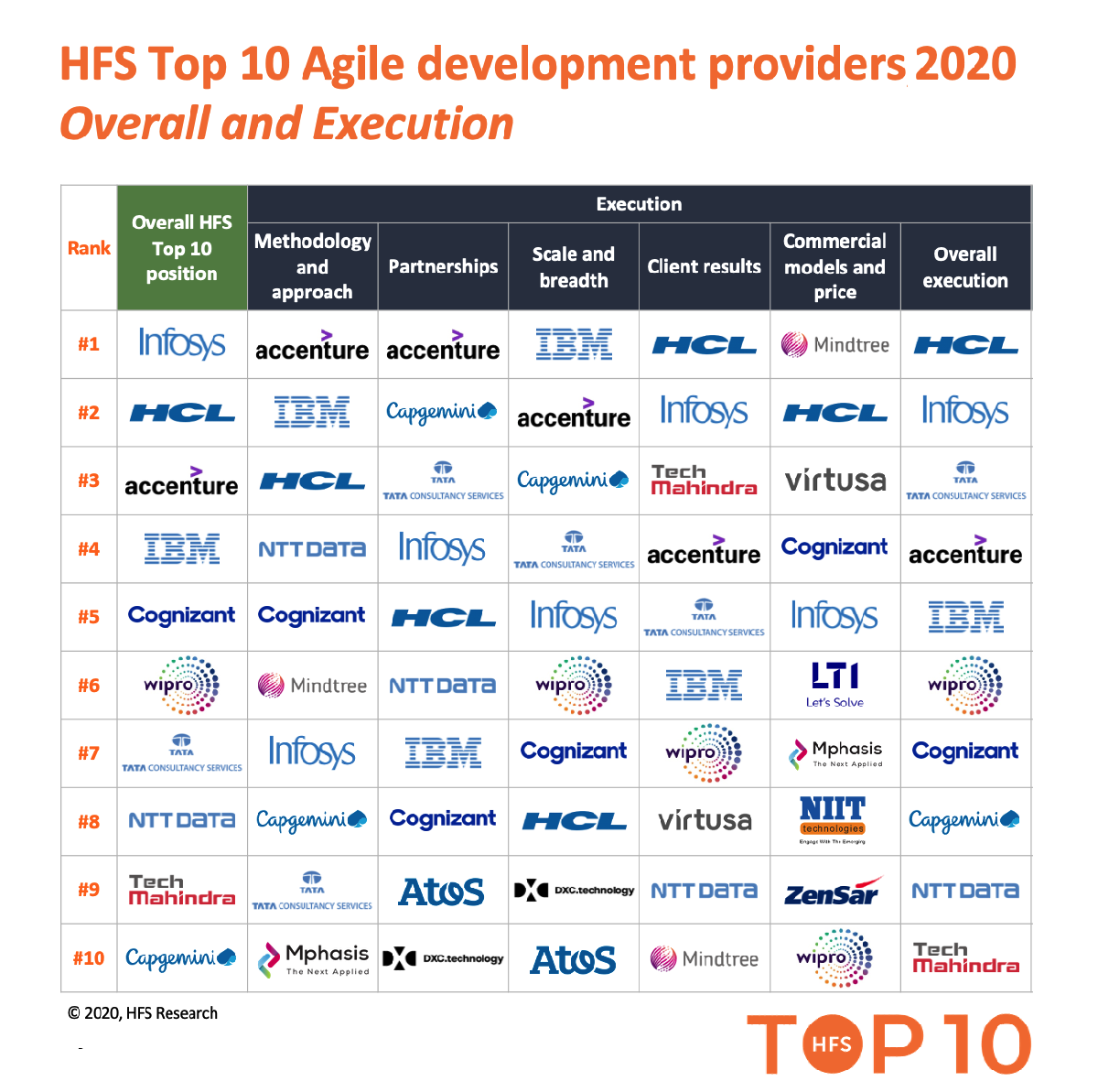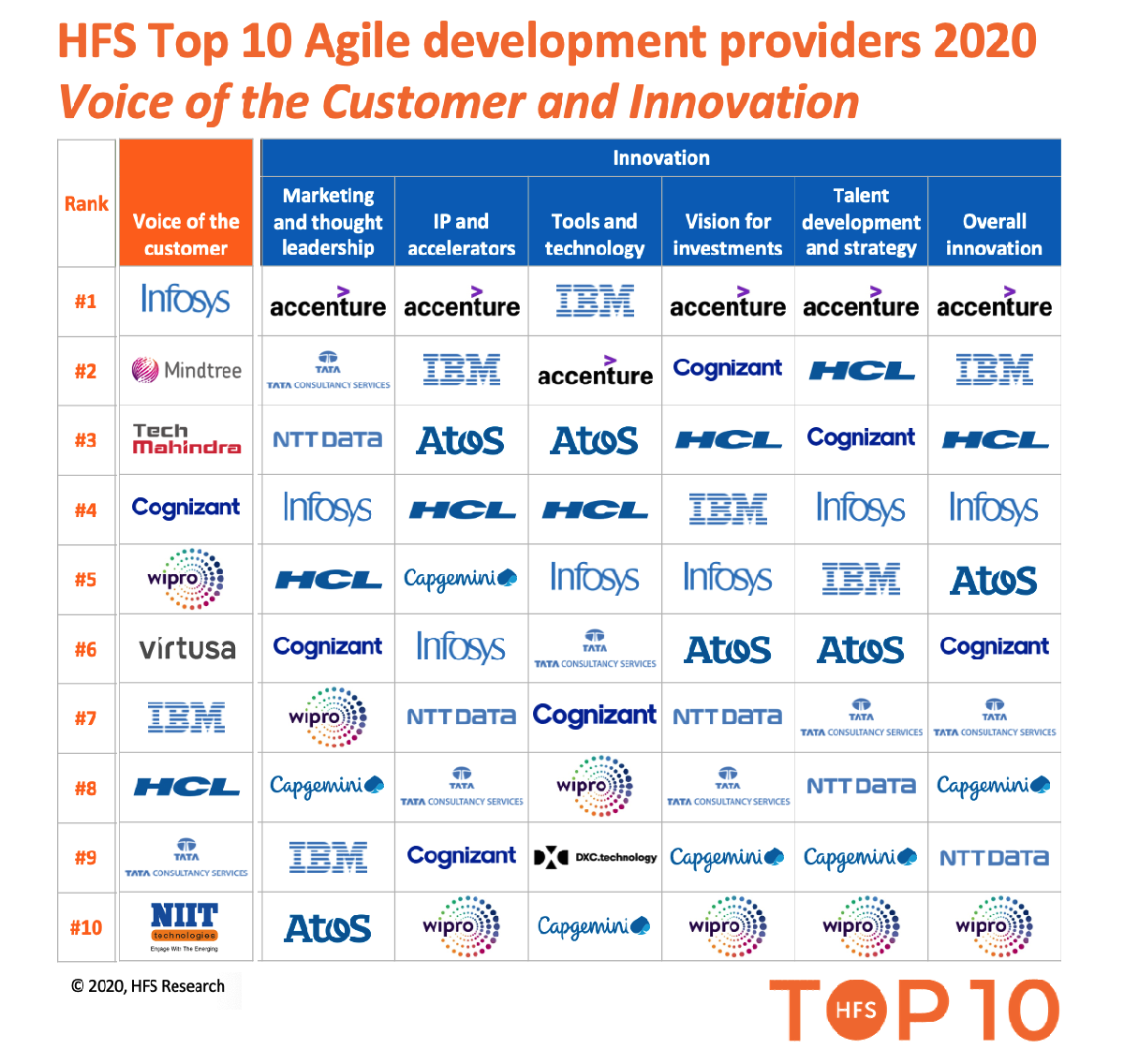Today’s environment is based on rapid decisions to move processes and apps into the cloud as fast as possible to keep companies functioning in a remote-working economy. That means it’s all-hands-on-deck to use all available resources to make this happen as cost-effectively as possible. The principles of agile development have never been as important.
Cloud computing is basically the Internet being used as the system for delivering processes, software, data, and other services. Being ‘agile’ means being able to use all resources as and when required. It also means not having to use them when not being used, and not pay for them. So how can we expect today’s service providers adopt agile development to help our enterprises make the leap to the cloud as effectively and rapidly as they can? Let’s ask HFS analyst Martin Gabriel who led the recent Top 10 report in Agile Development Services:

Martin – why has agile become so talked about in the recent past? Hasn’t this been around for ages?
Yes, that is very much true. In a nutshell, due to the following reasons, it took center stage – a) Because of the agile success rate in software development space, and b) the traction in organizational agility. It has proved that agile methodology enhances productivity and alpha, and if adopted appropriately, it reduces overall cost over a period of time. The agile concept has come a long way, it has evolved all the way through software development, but now has branched beyond IT and other departments like marketing, legal, HR, and much more. As the concept is getting increasingly popular across business areas, companies have started to witness higher returns because of this. However, this was only feasible because of the embracement it garnered from C-suite members in recent times. That being said, not all big firms embraced it, companies like IBM and GE witnessed a drop in their revenues as per a report on “Market capitalization of big firms.” On the contrary, firms like Amazon and Microsoft, who adopted agile practices at the top level, have delivered significant results over a period of five years. Companies like Netflix and Spotify were born agile, and they were far from being bureaucratic and hierarchical and are one of the fastest-growing. I believe these are some of the key reasons in recent times it’s been discussed a lot in my perspective.
And has anything changed significantly with the pandemic, or is agile now even more relevant in the current environment?
As we know, agile software development is all about being iterative and collaborative at work. During the pandemic, few agile teams struggled but bounced back faster. But few of them were not doing that well before COVID as well, and the pandemic triggered its downfall too. On the other side, teams that performed well before COVID have developed trust due to the work from home coming in to the play and also plugged mental health management models in the team that shaped them to perform better during the crisis.
While we see this in the organizational perspective, certainly, the pandemic has pushed the organizations to play with an unfamiliar swiftness, and that is how organizational agility became inevitable in today’s environment. Many non-agile organizations adopted agile operating model out of necessity, and it has significantly helped them to cope with the crisis regardless of industries.
With agile operating model adopted completely or partially, companies led with a smooth transition, efficient work management, and met customer needs within set timelines. In fact, within an organization, agile business units performed significantly well than the non-agile business units. We cannot deny the fact that non-agile organizations struggled to manage the remote work environment and resource prioritization.
The Challenge of performing well in crisis with agile models does not end here. The real test will begin when the same organizations who adopted the agile way of working out of emergency might have to figure out the most sustainable model that suits them after things settle down. The current operating model was only developed out of emergency and was not a well-planned one in the long run.
So, what impressed you – and disappointed you – the most when you conducted the briefings and enterprise reference calls during the recent T10 report? Did you feel the industry has been making a lot of progress with agile or is it more “lip service”, Martin?
What impressed me – Well, I have lot to discuss on this, starting from enterprise adoption rate of the Agile methodology to success rate, client relationship, providers’ willingness to go overboard, and to my surprise, commitment and impressive client relations. This is where some of the mid-tier players were able to demonstrate and deliver better than the tier 1 players – this does not mean that tier 1 players were less impressive or have not wooed their clients. Sometimes the complex management structure takes away the perk and makes it intricate and challenging to achieve desired results faster.
Flexibility, when I say flexibility, here I am talking about the willingness to flex resources if needed, flexible pricing, free hands-on choosing resources for their projects, open environment where developers from providers’ side were able to push back if that’s not the right approach and the willingness to go out of the box rather than sticking only with the contract.
These are some of the positive angles that few providers were able to pull off.
What disappointed me the numbers they gave for their agile resources. While conversing on providers’ strength in their agile practice, it was observed that the numbers of trained agile associates were a little unrealistic. Few providers mentioned more than 80% of their application development work in agile, whereas few of its peers only mentioned around 35%. These numbers lie in two ends and difficult to analyze.
Large organizations are still focusing on pleasing clients instead of being true to the name of agile engagement. Few agile team members were unable to have difficult conversations with their clients, instead, they agreed to every task thrown at them without explaining the challenges behind. In fact, they did not create room to push things back if they were unrealistic.
In my humble opinion, clients are very mature compared to many service providers. They have vast know-how and understand the ground-level challenges and common market problems better and on top of that, they have a willingness to cooperate.
Sometimes, client references given by the providers refuse to participate as there were no prior intimations given. These instances reflect that providers sometimes assume clients are happy and ready to share happy testimonials.
Across providers’ offerings, frameworks, partnership ecosystems, and capabilities are the same. End of the day it’s about customer satisfaction, overall experience, and pricing.
Answering the last part of your question, the Agile model indeed progressed over the years. It has almost replaced the traditional waterfall methodology. The agile failure rate is only 8%. Yes, it has its challenges too. Initial costs, unclear objectives that lead to constant changes, scaling across different teams and locations, resistance to change, and lack of executive support are some of the challenges.
Martin is actually pretty cool you know…
And which providers, Martin – in your view – distinguished themselves the most? And why?
Infosys, HCL, and Accenture bagged the top 3 ranks in our top 10 studies. Sometimes simple things make a huge difference, and in our agile study, that’s exactly what happened. I reiterate that customer feedback, pricing, and flexibility differentiates providers. Methodology, approach, partnership ecosystem, scale and breadth, IP, and accelerators are very close calls among the top players. It is tough to differentiate for buyers and even me as an analyst. Little you can make difference wherein the thought leadership, investment roadmap, and willingness to go that extra mile is the one that differentiates among the top players. Matter of fact, fourth, fifth, and sixth rank holders were very close to each other. They were equally good in most of the assessed parameters.
As we evolve rapidly into this new hyper-digital environment, how would you like to see agile evolve and a practice? What is your advice to young professionals in this space?
Well, agile is not limited to individual teams (say product development team) anymore; embracing the agile practice organization as a whole is the way.
Advice to young professionals – Coders who are developing agile competency will differentiate themselves and have a better advantage over others. Also, we are embracing organizational agility; therefore, an agile foundation or awareness is going to be inevitable.
Furthermore, some of the skills are often taken casually or being ignored. Agile team members must equally focus on developing soft skills like managing difficult conversations, the ability to present your work to a wider audience if needed. Being a good developer or coder isn’t sufficient anymore. Agile is about constant change and iteration and for that these skills are ideal.
And how would you describe the similarities between agile development and the rapid scaling up investments? How can we use agile to get to our “North Stars” faster these days?
In short, the Agile concept took years to reach where it is today. Even today, some of the top IT service providers agreed that only ~36% of their application development work is in agile. Similarly, scaling up agile has its own challenges. In the past, sr. leaders were very stringent in approving the budget. Last four-five years with proven agile results and an agile mindset, C-Suite members are open to scaling, and the COVID crisis further pushed the process.
Answering your second part of the question. We witnessed results in organizational agility over a period and it’s one of the big fuss in the industry right now. Also, in the recent pandemic, agile organizations were the ones who were able to swiftly move/adapt to the remote workspace than others. Leaving challenges aside, the benefits of organizational agility is faster adoption of changes, capitalization on new trends, and incline towards an innovative firm. I believe, in short, organizational agility is the best way to reach our North Stars, faster. There are a lot of steps and approaches to be followed, that is another discussion altogether.
Premium HFS subscribers can click here to download the Top 10 report in Agile Development Services
Posted in : Agile, Cloud Computing, IT Outsourcing / IT Services, OneOffice








